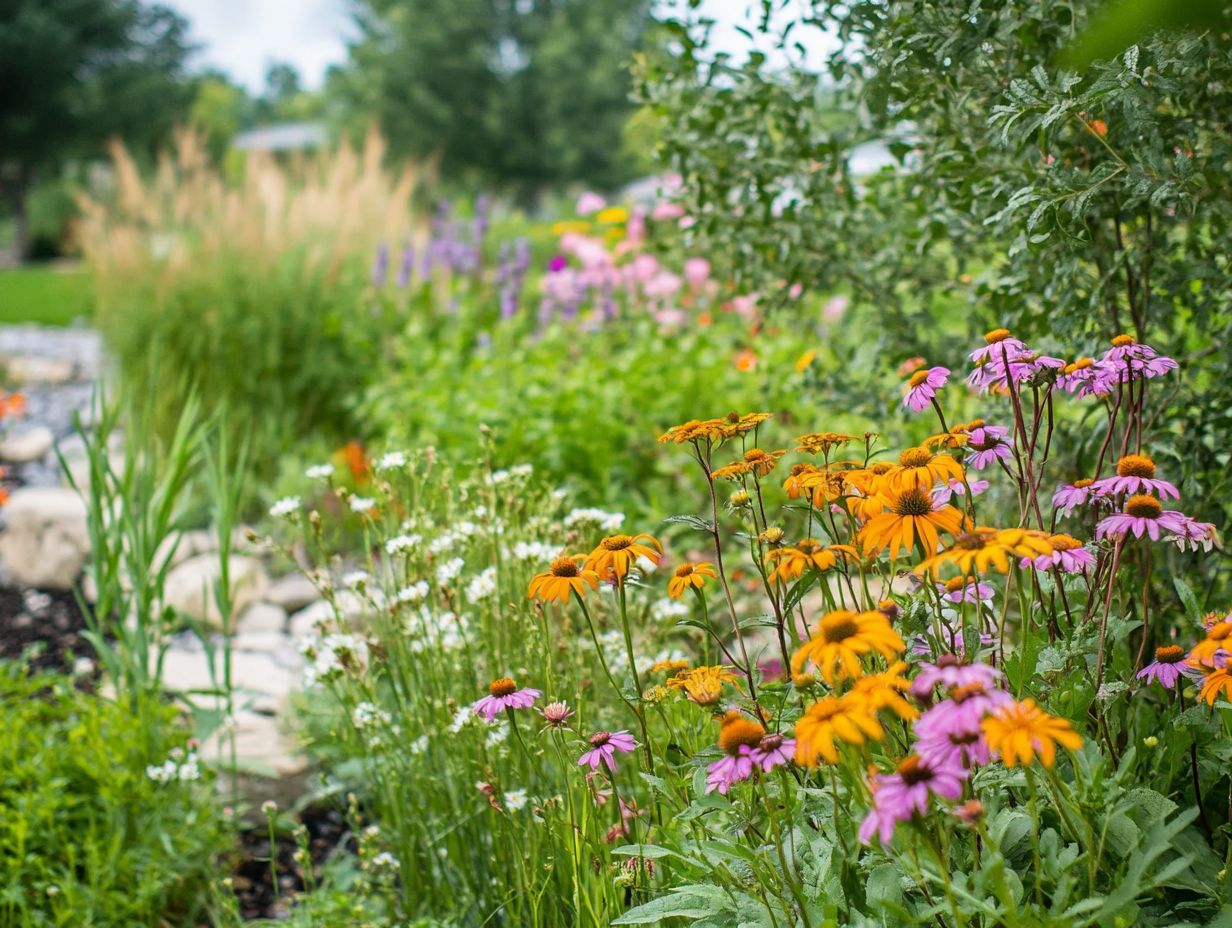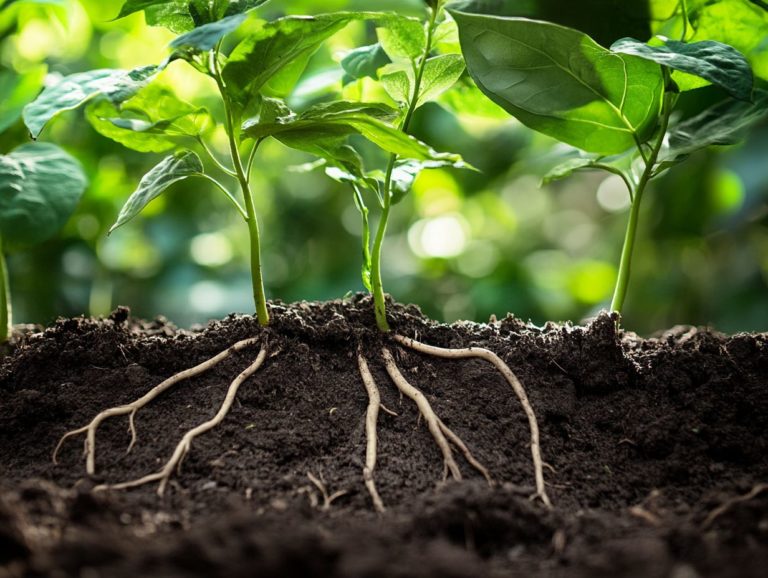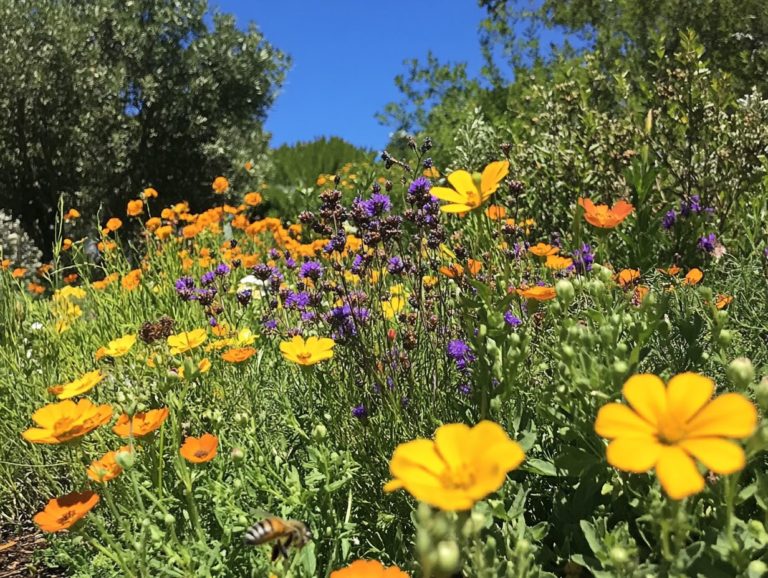How to Use Rain Gardens Effectively
Rain gardens are not just beautiful; they play an important role in managing water that comes from rain and flows over surfaces like roads, helping local ecosystems and acting as a form of green infrastructure.
Let s dive into the amazing world of rain gardens! We ll explore their many environmental and aesthetic advantages and provide simple design guidelines for creating a rain garden that enhances your space.
You ll get a step-by-step guide for building and maintaining your rain garden, including tips to boost its efficiency. Whether you re an experienced gardener or just starting, you’ll find valuable insights to cultivate your own flourishing rain garden, featuring the best perennial plants for your area.
Contents
- Key Takeaways:
- What is a Rain Garden?
- Benefits of Rain Gardens
- Designing a Rain Garden
- Building and Maintaining a Rain Garden
- Maximizing the Effectiveness of Rain Gardens
- Frequently Asked Questions
- What is a rain garden and how can it be used effectively?
- Where should I place a rain garden to maximize its effectiveness?
- How do I design and construct a rain garden?
- What types of plants should I use in a rain garden?
- How do I maintain a rain garden to keep it effective?
- Can a rain garden be used in all climates?
Key Takeaways:

- Rain gardens help prevent pollution and reduce erosion while adding beauty to your outdoor landscape.
- They improve water quality and provide vital habitats for wildlife.
- To maximize their benefits, design and maintain rain gardens carefully, and consider using additional techniques like rain barrels and permeable paving for better water conservation.
What is a Rain Garden?
A rain garden is a special garden design created to manage stormwater runoff by capturing rainfall and allowing it to soak into the soil. This is an effective way to reduce surface water while improving water quality.
By using native plants that thrive in your local environment and making necessary soil adjustments, rain gardens mimic natural ecosystems. They provide ecological benefits while beautifying your outdoor spaces. This technique not only helps with urban runoff management but also creates homes for wildlife, increasing the variety of plants and animals.
If you’re looking to enhance your drainage systems and reduce flooding, a rain garden is a beautiful and cost-effective solution for managing excess water.
Definition and Purpose
The main goal of a rain garden is to manage stormwater runoff while improving water quality using native plants and soil enhancements tailored to different soil types.
When designed thoughtfully, these gardens use native plants to absorb excess rainfall, which helps minimize runoff and filter out harmful pollutants. Choosing the right plants not only enhances soil infiltration but also creates diverse habitats for wildlife, including pollinators and beneficial insects.
This boost in biodiversity is essential for restoring local ecosystems. Rain gardens are a fantastic way to enhance your landscape and engage your community by effectively managing stormwater and supporting local wildlife.
Benefits of Rain Gardens
Rain gardens provide numerous benefits, including better water quality and less stormwater runoff. They are excellent at managing water effectively, creating vibrant habitats for wildlife, and adding a striking visual appeal to your outdoor environment.
Start your rain garden now and watch your outdoor space flourish!
Environmental and Aesthetic Benefits

Rain gardens offer impressive environmental benefits. They act as natural filters, reducing excess rainwater and improving water quality, all while adding beauty to your outdoor space.
These gardens also capture pollutants before they reach waterways. They stabilize soil with native plants that have deep roots, helping them retain moisture and support local ecosystems.
Thoughtful plant selection can create vibrant landscapes that thrive in various garden settings. Rain gardens attract beneficial insects and wildlife, restoring habitats in urban areas and contributing to ecological balance.
Designing a Rain Garden
Designing a rain garden requires careful planning. Focus on its location, size, and plant selection to ensure it meets local regulations and manages rainwater effectively.
Location, Size, and Plant Selection
Choosing the right location and size for your rain garden is crucial. This directly impacts how well it captures excess rainwater and improves drainage.
Look for areas that naturally collect water, like slopes or spots near downspouts. The size should match the drainage area to manage rainfall efficiently without overwhelming the system.
Using native plants supports local wildlife and helps the garden thrive in local soil and climate. Together, these elements create a sustainable rain garden that benefits both nature and your community.
Building and Maintaining a Rain Garden
Building and maintaining a rain garden requires attention to detail. Follow construction instructions closely, execute the excavation carefully, and apply soil amendments wisely.
This diligence fosters healthy plant growth, creating a thriving ecosystem that supports diverse flora and fauna.
Step-by-Step Guide and Tips

Building a rain garden involves critical processes, including digging, proper soil amendments, and ongoing maintenance to ensure long-term effectiveness. This emphasizes the need for effective vegetation management.
Understanding these essential elements can significantly enhance the beauty of your landscape and its functionality in managing stormwater, while adhering to local regulations. Begin with careful site selection; identify areas where runoff tends to accumulate and assess the sunlight conditions. Take into account both water drainage and plant adaptability.
Once you lay the groundwork, it’s time for digging. Aim to create a shallow depression that ranges from six inches to one foot deep. This will allow for effective drainage and optimize soil infiltration. Next, incorporate soil amendments like compost and sand to improve both drainage and nutrient content, ensuring optimal conditions for your plants and supporting their long-term health.
Selecting the right native plants is crucial. They adapt well to local conditions, support local wildlife, and contribute to habitat restoration. To promote ongoing health, establish regular maintenance practices such as mulching, periodic weeding, and ensuring adequate water retention to sustain your rain garden’s health. These steps will ensure your rain garden thrives and delivers amazing ecological benefits!
Maximizing the Effectiveness of Rain Gardens
To maximize the effectiveness of rain gardens, consider implementing techniques and strategies that enhance their ability to capture runoff and promote water conservation. This makes them vital components of sustainable water management and helps create a more sustainable environment.
Additional Techniques and Strategies
Incorporate more techniques into your rain garden design to greatly enhance its ability to control runoff and improve overall water quality. This ensures compliance with state regulations.
Utilize layered plantings to cultivate a diverse ecosystem that promotes resilience and effective water absorption. This contributes to a thriving habitat for wildlife. This approach maximizes your available space and encourages beneficial interactions among plant species.
Also, adding soil amendments like compost or biochar can significantly enhance nutrient retention and improve soil structure. This makes it more conducive to plant growth and effective water drainage.
Integrate water-smart design principles, such as strategically placed permeable pathways. This will direct excess water toward your garden, promoting better stormwater management while enhancing the garden’s functionality.
Embracing these innovative solutions allows you to transform your rain garden from a mere landscaping feature into an essential tool for sustainable water management and effective runoff control.
Frequently Asked Questions
What is a rain garden and how can it be used effectively?

A rain garden is a landscaping feature designed to capture and absorb rainwater runoff from rooftops, driveways, and other impermeable surfaces. This helps mitigate urban runoff. You can use it effectively to reduce erosion, improve water quality, and provide habitat for pollinators and other wildlife. This showcases how rain gardens help the environment.
Where should I place a rain garden to maximize its effectiveness?
The best location for a rain garden is in a low-lying area of your yard, where water naturally flows during heavy rain. This optimizes its runoff control abilities. It should be placed at least 10 feet away from your home’s foundation and any septic systems, and at least 25 feet away from wells or bodies of water, in accordance with state regulations.
Get started on your rain garden today and make a difference in your backyard!
How do I design and construct a rain garden?
Start by deciding how big and what shape your rain garden will be. This depends on how much runoff it needs to manage.
Next, dig a shallow basin and add gravel at the bottom for drainage. Finally, fill the basin with native plants and mulch to absorb and filter the water.
What types of plants should I use in a rain garden?
Using native plants is key to a thriving rain garden! They adapt well to local conditions and need less maintenance.
Choose plants with deep roots that can soak up water and handle both wet and dry conditions. Great options include purple coneflower, black-eyed Susan, and switchgrass.
How do I maintain a rain garden to keep it effective?
To maintain your rain garden, regularly remove debris and weeds. Keep the soil moist but not soggy, and add mulch or fertilizer as needed.
Also, monitor your plants’ health. Replace any that die or become overcrowded to keep the garden thriving!
Can a rain garden be used in all climates?
Yes, rain gardens can work in any climate! However, designs and plant choices will differ based on rainfall amounts and frequency.
Consult a local expert for tailored advice on how to create an effective rain garden in your area.






